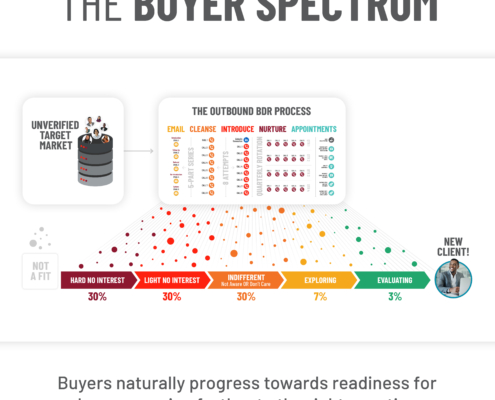

Imagine this: You’ve been chatting with a person consistently, and they agree to meet you for the first time. You drive to where you’re supposed to meet. You grab a seat and wait for them to arrive. About 10 minutes roll by, but that’s okay—maybe they needed to stop and put gas in their car. Next thing you know, it’s been an hour, and still, no one shows. As much as you don’t want to believe it, you conclude that you were stood up.
Was it something you said earlier? Why the change of heart with no warning? We get it—meeting with qualified leads for a potential B2B partnership is stressful. Honestly, getting ghosted can hurt worse than being rejected in the first place.
B2B sales development representatives (SDRs) typically don’t think about meeting no-shows until it happens to them. No-shows can occur for various reasons, and they’re often out of your control. However, the risk of no-show sales appointments can be minimized with the right approach.
Throughout this blog, we’ll discuss:
Why Prospects Don’t Show Up
No-shows are a common obstacle for nearly all sales teams at one time or another. Two of the main reasons why a prospect doesn’t show up for a sales appointment are emergencies and priorities.
Emergencies are often the main reason why decision-makers no-show sales meetings. Things come up that simply cannot be avoided, like car troubles, health concerns, late-notice department meetings, etc. Unfortunately, there’s nothing SDR teams can do to get rid of emergencies. However, SDRs can follow up after the anticipated sales meeting and propose a new date and time to meet.
More often than not, no-show sales appointments occur due to organizing priorities. When other tasks come up that take precedence, a B2B meeting (especially with a company unfamiliar to the prospect) is pushed to the side and forgotten about. Prioritizing other responsibilities is sometimes intentional by the prospect, but it can be accidental.
If you’re concerned that prioritizing other meetings and tasks is intentional, give the prospect a reason to prioritize the sales meeting. For example, if the prospect is busy and says that they have to work late in the evening, emphasize how your company’s product or service allows them to even out their work-life balance.
Additionally, it’s important to consider the dates and times SDRs pitch sales meetings to prospects. If it’s after a holiday or long weekend, prospects are more likely to no-show sales meetings because it’s more than likely pushed to the back of their minds and they jump back into their everyday routine. When SDRs schedule sales meetings, it’s vital to consider what other factors may get in the way, increasing the risk of a no-show.

How to Prevent No-Shows From Happening
While sales appointment no-shows are inevitable, there are ways to prevent no-shows from happening. Here are some successful ways for SDR to prevent no-shows for sales appointments:
Set Meeting Expectations When Scheduling
As SDRs schedule sales appointments, it’s important that they give the prospect everything they need to be prepared and have a good meeting. This includes setting clear expectations on how and where the meeting will occur.
In the past, many sales meetings occurred in person. While this is often still the case, many businesses that serve regions across the country (or even the world) schedule virtual sales meetings rather than face-to-face.
As a response to the COVID-19 pandemic, virtual sales meetings started to become more and more common. According research conducted by HubSpot, 63% of sales leaders believe virtual sales meetings are equally effective (if not more effective) as traditional, face-to-face meetings.
If SDRs schedule virtual sales meetings, your prospect has to have all the information to make sure they know how they’re meeting, whether it’s through Zoom, Google Meet, or another virtual communication platform.
The prospect also absolutely has to know who they’re meeting with and what value that person holds. This gives them an idea about who the person pitching them is, why they should trust them, and what they have to say about your company’s product or service.
Send Sales Appointment Confirmations via Email
After an SDR gets off the phone with a prospect, they should follow up the conversation with an sales appointment confirmation via email.
The subject line of the sales meeting confirmation email should include the first and last name of the prospect and their company name. The entirety of the confirmation email should focus on the prospect, not a mountain of information about your business.
When SDRs craft sales appointment confirmation emails, it’s important to keep the body of the invite short and sweet. Sharing relevant case studies or testimonials is a good idea for preventing no-shows because it gives concrete evidence of how your company’s services help. Let’s say that your SDRs secure a sales appointment with a commercial cleaning company in St. Louis. In the appointment confirmation email, it’s important that they include a testimonial of a commercial HVAC client in St. Louis, because this showcases the value of your business.
When sharing case studies, it’s important to share the subjective positive impact as well as the objective impact. This can include using numbers and metrics to further drive your point and fully resonate with the prospect, like how much money one of your clients have saved because of your company’s services, or how much revenue your service has been able to generate for your client over a specific period of time.
Schedule Meaningful and Reliable Appointments
We’ve all sat through tedious meetings that could’ve been an email. Don’t anticipate this B2B sales meeting as one that could’ve been summed up in an email. When an SDR pitches your company’s product or service, add value that’s relevant for the prospect and set an agenda for what your sales executive would like to cover.
Setting an agenda gives the prospect a reason to show up and gives them an idea of what information they should have prepared before the meeting. This gives them more responsibility for the meeting because they need to bring something to the table rather than just show up for the sake of showing up. Preparing a call to action for the prospect also engages them to learn more about your company before the meeting takes place.
Make Sure You’re Talking With the Right Person
One of the biggest mistakes you can make as an SDR is setting up an appointment with the wrong individual. Scheduling appointments with someone who is not a decision-maker is a waste of time and resources. Additionally, it can lengthen the amount of time a prospect spends in the sales cycle. Speaking with decision-makers is crucial for B2B appointment setting because they have the power to make financial decisions and will ultimately be the ones to close the deal.
Going through the lead qualification process allows SDRs to avoid setting up appointments with individuals who don’t have purchasing power. For example, if an SDR is speaking with someone who says they’re in charge of the building’s HVAC systems but don’t have buying power, SDRs should feel free to ask them questions about their purchasing process to understand their current situation better. This could help them get in touch with the best point of contact and close a deal.
Send Appointment Reminders
Whether it’s a phone call or an automated appointment reminder by email, these are significant touchpoints to implement into your appointment setting practices to increase your show rate. Potential customers are busy just like you, and without a simple reminder, an important meeting like this one may slip their minds.
When the day of the meeting comes and you notice a prospect hasn’t accepted the calendar invite yet, it may be worth sending a follow-up email. As we all know, business gets busy and hectic sometimes, so it’s easy to forget about important matters if there are so many other things coming at you head-on. Here’s an example of what a reminder email could look like:
At the time of the appointment, it’s important that SDRs and sales execs show up on time, if not 10 minutes sooner to make sure everything is set up and working properly for the sales presentation. After a few minutes have passed and there’s still no word from the prospect, it’s important to follow up once again with a simple message like this:
“Hey Mark, we’re waiting for you on the Zoom call! Can you hop on?”
Once the email is sent, it’s important to also make a phone call to the prospect to see if they need help connecting.
Keep Track of No-Show Response Rates
No-show sales appointments are a pain, but they’re bound to affect your response rates every so often. Tracking the frequency of no-show sales appointments is a great way to identify gaps in communication and discover ways to improve meeting attendance.
Most businesses should aim for a no-show rate of less than 20%. Even if your company’s no-show rates are less than 20%, there are always ways to decrease this percentage. A CRM platform is great for tracking no-show response rates because it can show you those percentages. Additionally, a CRM can provide extremely helpful data for SDR teams to use to identify potential common denominators of prospects who no-show sales meetings.
What to Do if a Prospect Doesn’t Show Up to an Appointment
Maybe it’s the first time a hot lead has ghosted you or maybe it’s the fifth time you’ve tried meeting up and they go silent. Let’s take a step back and look at the glass half full. Just because they no-show an appointment doesn’t mean that they don’t need your business. After a sales appointment is missed, try these tactics:
Follow Up
After a prospect doesn’t show up to a sales appointment, follow up with them by email or phone call to reconnect and make sure they are okay. As mentioned earlier, emergencies and priorities come up that are out of your control. Since they didn’t make it to the appointment, following up shows that you care about their well-being. This also adds an additional touch to the relationship and builds on the connection for when you and the prospect meet for the first time.
Pick a New Date and Time
Once you follow up with the prospect, schedule a new date and time that works better for them. If the initial date and time you proposed are typically busy, suggest a new day of the week when they’re more available.
If too much time has passed between the missed appointment and the last time you talked to them, it may be best to set this opportunity up as a new pitch. Remind them of the previous conversation you had and discuss what they said they were interested in. From here, tell them you’d like to set up a new date and time to meet and discuss how your company could serve them and their business.
Set Action Items
Creating action items for the prospect puts more of a responsibility on them for the meeting. By developing action items, the discussion becomes more engaging than simply sitting in and listening to the conversation.
Put Them Back in the Sales Pipeline
Unfortunately, you can’t always get a prospect to agree to set up a new meeting time. Once a significant amount of time has passed after the missed appointment, it may be best to put them back into the sales pipeline. Putting them back into the sales pipeline and nurturing the relationship continues the prospecting process so you can reach them when the timing is more relevant.
Key Takeaways
While you can’t guarantee a 0% no-show rate, there are measures you can take to boost sales appointment show rates. These measures include setting high-quality appointments, speaking with the right decision maker, scheduling closer to the appointment set date, and sending reminders.
Even if a prospect doesn’t show up and doesn’t want to reschedule an appointment, it’s vital to remember that there are plenty of other fish in the sea. Even though that partnership wasn’t an immediate fit, there are plenty of other prospects out there that are looking for a solution that you can provide for them.
Not every company has the tools, technologies, or capabilities to set sales appointments that have value. That’s why businesses reach out to us to maximize their B2B sales efforts. If you’re looking to increase your appointment show rates, reach out to Abstrakt Marketing Group today to schedule a demo of our B2B appointment setting services!





